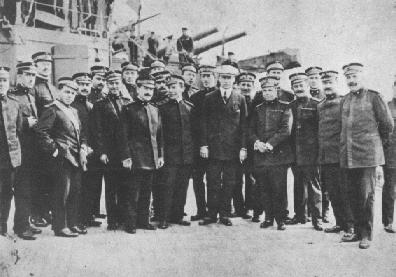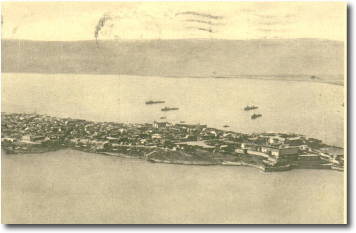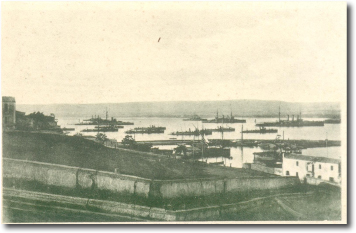[Historical notes]
The “RADIOTELEPHONY”
Cannot be spoken of the existence of an original invention of the radiotelephony, since it
has been a consequence "substitute" deduced by the radiotelegraph.
 Without
removing praise and merit from the notable and chosen work of the prof. Majorana, needs to
share what, with perfect adherence to the times and the circumstantial formalities it had
to expose the Marchese Luigi Solari:
Without
removing praise and merit from the notable and chosen work of the prof. Majorana, needs to
share what, with perfect adherence to the times and the circumstantial formalities it had
to expose the Marchese Luigi Solari:
"The radiophone has not come into the play of the practices applications that
after introduction of the thermionic valves. The prof. Fleming of the University in London
was first to introduce together with Marconi, of which it was collaborator, the thermionic
valves in the radiocomunicationis. Meissner, Armstrong, Langmujer, De Forest, Franklin,
Round has gotten brevets for the transmission radiotelephony with thermionic valves,
thanks to which, I repeat, the radiotelephony has succeeded in assuming a breadth and
practical development. It finally results in incontestable way that through the fittingses
to thermionic valves, to which Marconi has given the most greater impulse and the special
lengths of wave determined by same Marconi, have been possible to realize the first
efficient services radiotelephonyc and the first transmission of the human word from
Europe to Australia through. often Understands that every great invention boasts its
disciples but the new conquests of the portentous human activity, holding the work of the
triunph lives, they don't darken him when they contribute to create in the environment in
which it flourishes a concomitance of contributions converging in new destinations. It is
important to know that to the applause of the world press for the Santoro prize granted to
the prof. Majorana, Marconi added her gratification in to see that "the first place
in these studies was taken by an Italian."
After the invention of the radiotelegraph, they had been done in Italy you launch attempts
to realize the telephony without thread. It needed, first of all to prepare of so that
carrying constant in ampleness, persistent and continuous in the generation and in the
propagation; it was not enough yet. The studies of the experimenters were turned to the
search of a microphone able to hold up to strong intensities of electric tide, since that
to coal granules was not proper: in fact the granules heating the ohmic resistance they
were decreased, and the microphone made him useless. For work of the prof. Majorana, from
1903 to 1912 (and from the prof.JGiuseppe Vanni), with the use of a special microphone to
liquid vibrating (says to water or hydraulic) in degree to sustain current intense
microphone and under high difference of potential, applied to a generator to arc Poulsen,
the spar he could be fed with enough quantity of energy. Year for year the progress
achieved by the prof. Majorana's are so realized.
- 1903: beginning
of the study of a system radiotelephon;
- 1904: realization
of clear radio broadcasts among two rooms of the laboratory (Telegraphic and Telephone
Superior Institute);
- 1907: broadcast
conversation among the laboratory and the strong one of Mountain Mario; among Mountain
Mario and Port of Anzio (52 kms); among Port of Anzio and the italian destroyer
“Lanciere”, in rout toward Sardinia (good receipts actually to 150 kms); among
Rome, Sardinia, Sicily, (Becco di Vela: 300 kms).
- 1908:
conversations among Rome and a receiver in London (in the Direction of the “Post
Office”); between Rome and Trapani (Mountain St. Giuliano) (420 Kms.).
The prof. Vanni to
get the telephony without thread, adopted a generator of so that to arc, conceived by
Moretti (two copper electrodes, a void) crossed by a throw of water, provided of slide
liquid microphone and vibrating foil. The first tests were performed to the Military
Institute Radiotelegraph in Rome, then with the station of Centocelle where the
transmitter had been fixed. From Centocelle him radiotelephone to Ponza (120 kms), to the
Maddalena (160 kms), to Palermo (420 kms) to Vittoria, near Ragusa (600 kms), and finally
to Tripoli (in 1911), to the distance from Centocelle of 1000 kilometers. The systems
Majorana and Vanni, as has been said, they represent an interesting initial footstep for
the development of the radiotelephony, old beginning from 1911 from the advent of the
thermionic valve. The to progress some technique in the construction of the triodes of
great power for the transmission and of strong output amplifier in the receipt, been worth
not to dissuade Marconi from the improvements introduced in the radiotelegraph, that a lot
of to abandon the long waves. The great turn happened with 1923 with the passage to the
short waves “to bundle” that they admitted the introduction of the radiophone
with the directional system on long journeys. The thought of Marconi is very clear as
always; it will admit “Her stations of great waves power long of this Country,
that currently expound a service commercial radiotelegraphic from and for the United
States, I am fit I hold, to transmit and to contemporarily receive in each some
directions, under normal conditions, with a middle speed of 20 words to the minute, for a
daily average of 18 hours. But the stations to bundle, in the official tests they have
already shown able to transmit and to contemporarily receive with a middle speed than at
least 100 words to the minute for 18 hours a day (and with a power at least 10 times
inferior of those to so that long). I would Like to add besides that I don't think but the
system about bundle is limited to the radiotelegraphic. I hope that it can be used for
bringing the radiophone on a base very more practice than it currently is not.”
And we were already in 1926.
The first experiments in this field introduced by the Italian Navy through the first
broadcast successes:
- in 1910 between Venice and La Spezia is experimented a generator of so that, modulated
in telephony, system Jacovello.
- in the 1913 Meissner, employing ionic valves, succeeded in getting a connection
radiotelegraphic producing entirely persistent, stable and constant oscillations.
Experimented for the first time to Rome near the Department of the Navy, the
radiotelephony it entered the current service of our ships in 1914, with the instrument
transmitter systematizes Marconi-Round (with thermionic amplifier).
On March 9th 1914, G. Marconi made to install the apparatuses on the Battle Ship
"Regina Elena", moored in the Port of Augusta (SR); (the signal was received by
a second vessel). Her two ships were directed in open sea and, for further experiments, in
front of the coast of Sicily, a perfect receipt was recorded on a distance of 35
kilometers, distance that for very limited once it increased in non clear way up to 70
kilometers. The communication was constantly maintained for a period of 12 hours and the
experiments they included periods in which the signals were transmitted both entirely on
the sea both con the interposition of the dry land.

They must also be remembered the connection in Phone, effected by the physician and
physicist Riccardo Moretti on behalf of the Regia Marina, between Rome and Tripoli in 1912
(1200 Kms).
From 1920 it begins the gradual diffusion of the radiotelephone on the ships and the
communications radiotelephonic they find the ideal field for their use. Since then thanks
to the rapid scientific progress, accompanied by conclusive technical improvements of the
apparatuses, the radiotrasmissionis have progressively reached the state in which you are
currently found.

It was custom of the great inventor, after the decisive experiences on the TSF telegraphy
without threads in the gulf of La Spezia in the July 1897 and the oceanic countries on the
Carlo Alberto of 1901-1902, to sustain himself in close contact with the Marina Militare
of the Kingdom of Italy.
Thanks to the I use free of the brevets Marconi, his technicians founding in the Arsenal
of La Spezia the first Italian shops of construction radio and the schools of training of
the personnel, with the rapids extension of the fittingses to ships and coastal stations,
brought notable contribution to the distance communications and to the problem solving of
the radiopropagation.
Here above to the center G. Marconi in the middle of the Most greater State of a battle
ship of the Regal Italian Marine, during the tests of radiotelephony among united' of team
with valve apparatuses (1914-1915)

